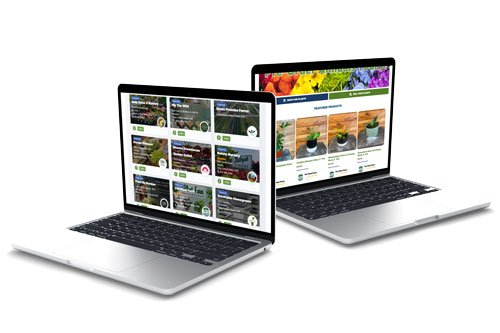2/1/2024
New Approaches to Buying & Selling Plants
Bill Calkins

In a recent Tech On Demand podcast, brought to you by GrowerTalks, the guest was Alsip Home & Nursery CEO Rich Christakes and the topic on the table was left wide open—to discuss “trends.” After chatting about the past season and some new varieties that had proved successful for the Indiana-based grower-retailer, the conversation moved along to labor, and then turned to buying and selling product. What Rich shared related to selling a detailed, very fresh approach to garden center retail and new ways to attract and excite shoppers.
Pictured: Rich Christakes, founder of Ship My Plants, CEO of Alsip Home & Nursery and co-founder of True Mtn Marketing.
But first, he described a new strategy at Alsip to help managers approach inventory turns in a way that not only increased the company’s profitability, but also put more money in the team’s pockets.
“We created new goals for supervisors and managers,” Rich said. “Not just sales, gross margin and payroll, but inventory-level goals.”
These goals related to product inventory reflected where the levels needed to be. The team was incentivized to be better buyers and put on an owner’s hat, in a way, he explained. The outcome increased profitability significantly in just one year, resulting in less dead inventory and more ability to be open to buy and turn product faster.
An Omnichannel World
To give managers and supervisors the most flexibility and opportunity to move inventory—beyond the walls of traditional brick-and-mortar stores—Alsip looked to alternative outlets online.
“We live in an omnichannel world, so we need to find different ways to attract customers,” Rich said. He explained recent research shows increases in plant spending, yet garden centers aren’t seeing all the gains. “Many of these new sales are happening online.”
Here’s an example Rich shared from 2023: Alsip was long on Karl Foerster grass, a result of producing too much at their nursery. They decided to put the long inventory for sale on an online multi-vendor marketplace at just over cost.
“We quickly sold them all to a landscape company,” Rich explained. “You need to give yourself as many ‘outs’ as possible with product and just selling them out gave us more cash to buy.”
Another time in 2023, Alsip turned to an online marketplace to move out product less than a month before Halloween.
“We went heavy into Halloween décor and the inflatables just weren’t selling,” Rich said. “We put them on Amazon’s multi-vendor site three weeks before the holiday and were selling five to seven each day for a few weeks.”
He noted they didn’t make much on them, but it turned back into cash and Alsip didn’t have to put the product back into the warehouse. The team learned a lesson not to go big into inflatables and avoided a significant revenue drain.
Enter Ship My Plants …
With experience in online selling, multi-vendor platforms and more general digital marketing, Rich was not only an early adopter with the team at Alsip, but also capitalized on his entrepreneurial spirit by founding one of the first plant-specific platforms. Called Ship My Plants, this new venture allows hort businesses to enter the omnichannel world of selling plants with very few barriers and countless opportunities.
 Pictured: Ship My Plants vendors target online shoppers with trending plants, as well as using the platform to engage new customers and encourage them to shop in local stores.
Pictured: Ship My Plants vendors target online shoppers with trending plants, as well as using the platform to engage new customers and encourage them to shop in local stores.
Through Rich and Alsip’s experience selling on website and Amazon, he understood the needs and created the innovative platform launched at AmericanHort’s Cultivate’23 event last July. Initially, Ship My Plants had four sellers. Now, there are 15 live sellers on the site and 10 more in the queue with plans for 50 in Spring 2024, Rich said.
The multi-vendor marketplace aggregates sellers who specialize in different crops. With shoppers turning online to buy trending houseplants and other specialty garden items, growers can target this new audience with the hottest plants available on Ship My Plants and send them out to a national audience.
But that’s not all, Rich said. Perhaps the most exciting thing for traditional garden center retailers is that the platform is also set up as a way for garden centers to operate like restaurants do with DoorDash or Uber Eats.
“Retailers can set up delivery zones by ZIP code and price just as they would taking a delivery on their own truck from a phone order,” he explained. “If a customer is searching and is not in that ZIP code, the garden center does not show up.”
This leverages the seller’s own brand, creating a unique store on the site—with their own inventory —and doesn’t take away from what they’re already doing. It’s not an either/or, but an AND, he said.
Some Specifics
Rich and the Ship My Plants team did a lot of homework and development before launching the platform. They carefully considered many of the potential challenges and barriers that growers and garden centers might encounter to reduce time spent setting up online stores and managing a new way of selling plants. That’s where the “from the industry” benefit comes into play and creates far more value than an off-the-shelf platform developed by a tech firm trying to engage with our industry.
“The user experience from the consumer and seller side is fantastic,” Rich said. “Sales tax is handled by the platform. Ship My Plants integrates with Ship Station for shipping, and we handle the advertising and marketing.”
In addition, sellers can list one plant they’re long on or five (or more). This avoids the “endless aisle” of products that frustrates buyers on so many online sales platforms.
A logical next question is: How will shoppers learn about the plants available and if they’ll work in their landscapes or gardens? Rich explained the plant information for each variety on Ship My Plants is powered by NetPS Plantfinder from Northscaping.
“It’s the world’s largest plant database and delivered by regionality on the platform,” he said. “So a plant like lantana appears as an annual to gardeners in Chicago, a perennial to someone in Tennessee and a shrub for Floridians.”
This is also a benefit to sellers who can be assured their plants are appearing correctly by region. Stores can just enter their store SKU, retail price and quantity available, and Ship My Plants takes care of the rest.
The website is a way to engage new shoppers online and leverage that first sale online into in-person shopping as a trusted seller. GP
Visit shipmyplants.com and start exploring the Ship My Plants multi-vendor marketplace!
Listen to the full Tech on Demand podcast, brought to you by GrowerTalks, with Rich Christakes.